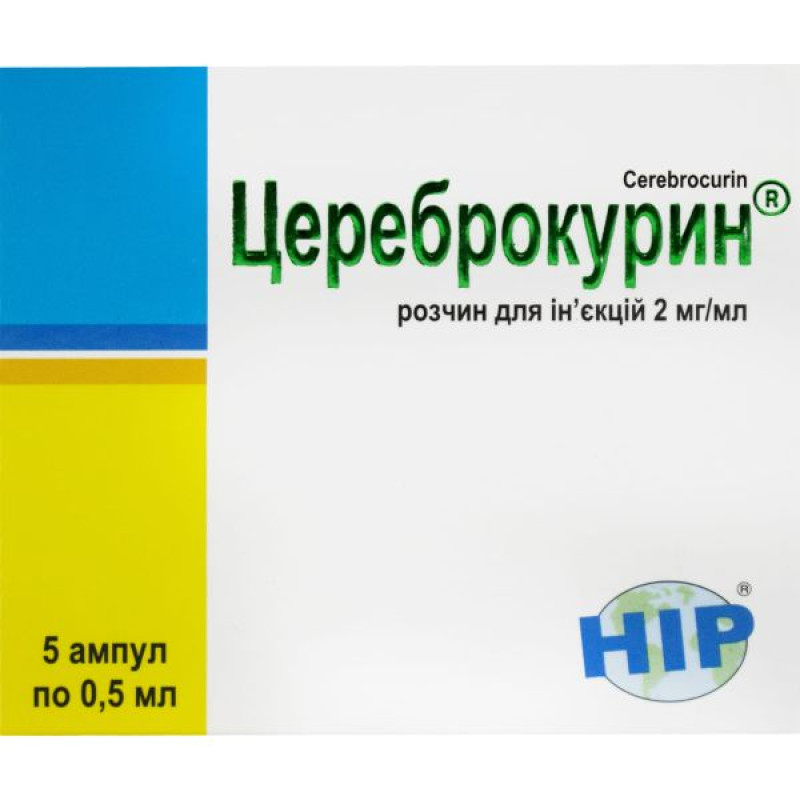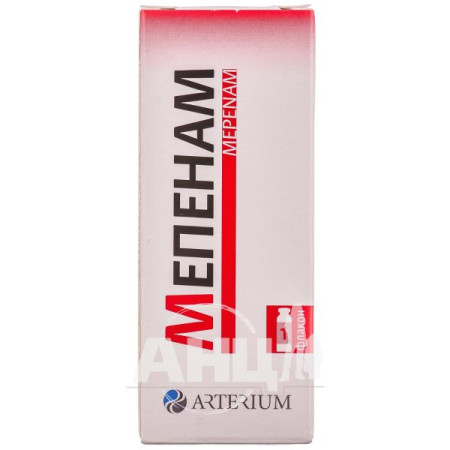Cerebrocurin solution for injection ampoule 0.5 ml No. 5

Pharmacological properties
Pharmacodynamics. The peptide modulator cerebrocurin has a positive effect on higher nervous activity by activating the energy-producing and protein-synthesizing function of nerve cells, increasing the activity of the synaptic apparatus of neurons.
Cerebrocurin helps to increase the diameter of mitochondria, their area per unit volume and restore myelin sheaths in brain neurocytes, mosaic destruction of which occurs during hypoxic damage to neurocytes. The drug has a nootropic and vasoactive effect, exerting a regulatory effect on the bioelectric activity of the brain.
Cerebrocurin improves arterial and venous cerebral blood circulation. Nootropic, hypolipidemic, hepatoprotective, anabolic action promotes the restoration of impaired CNS functions caused by both functional and organic brain damage, normalization of emotional and memory functions, expands the range of adaptive reactions, which contributes to the physical, mental and social rehabilitation of patients with nervous and mental diseases.
In hereditary and genetically determined diseases, Cerebrocurin has a stabilizing nootropic effect.
Pharmacokinetics. The study of pharmacokinetics is impossible, since the active neuropeptides that make up the drug are contained in the body in the form of high-molecular precursor proteins, the biosynthesis of which occurs in the postnatal period.
Indication
Diseases characterized by dysfunction of the central nervous system, in particular various forms of neurocirculatory dystonia, chronic ischemic dyscirculatory and post-traumatic encephalopathies, residual effects of acute cerebral circulation disorders.
As an adjuvant - after neurosurgical reconstructive operations on the main vessels of the head, in Alzheimer's disease, Binswanger syndrome (ischemic periventricular ariolis), in chronic fatigue syndrome and senile dementia of vascular genesis; mixed forms of dementia, intellectual dynamic disorders, psychoorganic syndrome with intellectual disability; consequences of encephalitis; Down's disease, Rett and Martin-Bell syndromes.
In ophthalmological practice - senile macular degeneration (dry and wet forms), high degree of complicated myopia, conditions after retinal detachment; partial atrophy of the optic nerve, post-traumatic macular degeneration, central serous chorioretinopathy, non-proliferative diabetic retinopathy without pronounced edema of the macular area, glaucoma with compensated intraocular pressure.
In pediatric practice - with delayed mental development and speech, congenital alalia and dyslexia, consequences of stroke with aphasia, cerebral palsy with psychospeech delay (mild degree), apalic (decortication) syndrome - in the subacute period and its consequences without frequent epileptic seizures, consequences of encephalitis or craniocerebral trauma with disorders of intellectual functions and persistent cephalalgias, flaccid paralysis. In the neonatal period - with moderate and severe asphyxia, consequences of severe chronic hypoxia.
Application
Cerebrocurin is administered intramuscularly.
Adults should use 2 ml daily. The minimum course of treatment is 10 injections. Patients with severe organic brain lesions, Alzheimer's disease require longer treatment; the course can be increased to 40 injections, repeated courses are recommended 2-3 times a year.
In pediatric practice, use from the first days of life and up to 6 months of age - 0.5 ml every other day, 3-5 injections per course of treatment; at the age of 6 months to 1 year - 0.5 ml every other day, 10 injections per course of treatment; for children aged 1-3 years - 1-2 ml every other day, 10 injections per course; over 3 years of age - 2 ml every other day, 10-20 injections. It is advisable to repeat courses (2-4) after 1-3 months.
Newborns and children under 3 years of age should be treated with the drug in a hospital setting.
In ophthalmological practice, Cerebrocurin is administered intramuscularly: 2 ml daily or the first 5 injections intramuscularly, then 1 ml peribulbar, 1 ml intramuscularly. Injections are performed daily, without interruption. The minimum course of treatment is 10 injections.
Children. In pediatric practice, it is used from the first days of life.
Contraindication
Increased individual sensitivity to the components of the drug, pregnancy and breastfeeding.
Side effects
Individual sensitivity to the components of the drug is possible. When using the drug in the treatment of patients with cerebral palsy with symptomatic epilepsy, such side effects as increased frequency of seizures, headache, and excessive excitability are possible.
Special instructions
Prescribe with caution in cases of allergy. Patients with status epilepticus and seizures should use Cerebrocurin under the supervision of a physician.
Children are not recommended to use Cerebrocurin at night.
During treatment with the drug, alcohol should not be consumed.
Use during pregnancy and breastfeeding. Cerebrocurin is not recommended for use during pregnancy and breastfeeding.
The ability to influence the speed of reactions when driving vehicles or working with other mechanisms. Does not affect the ability to drive vehicles and work with other mechanisms.
Interactions
No interaction was observed.
Overdose
Storage conditions
In the original packaging at a temperature of +2 to +8 °C, out of the reach of children. Do not freeze!
There are no reviews for this product.
There are no reviews for this product, be the first to leave your review.
No questions about this product, be the first and ask your question.

